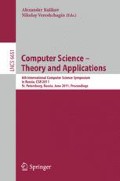Abstract
A binary matrix has the Consecutive Ones Property (C1P) if there exists a permutation of its columns (i.e. a sequence of column swappings) such that in the resulting matrix the 1s are consecutive in every row. A Minimal Conflicting Set (MCS) of rows is a set of rows \(\mathcal{R}\) that does not have the C1P, but such that any proper subset of \(\mathcal{R}\) has the C1P. In [5], Chauve et al. gave a O(Δ2 m max (4,Δ + 1) (n + m + e)) time algorithm to decide if a row of a m ×n binary matrix with at most Δ 1s per row belongs to at least one MCS of rows. Answering a question raised in [2], [5] and [25], we present the first polynomial-time algorithm to decide if a row of a m ×n binary matrix belongs to at least one MCS of rows.
Partially founded by ANR Project 2010 JCJC SIMI 2 BIRDS.
Access this chapter
Tax calculation will be finalised at checkout
Purchases are for personal use only
Preview
Unable to display preview. Download preview PDF.
References
Bartholdi, J.J., Orlin, J.B., Ratliff, H.D.: Cyclic scheduling via integer programs with circular ones. Oper Res. 28(5), 1074–1085 (1980)
Bergeron, A., Blanchette, M., Chateau, A., Chauve, C.: Reconstructing ancestral gene orders using conserved intervals. In: Jonassen, I., Kim, J. (eds.) WABI 2004. LNCS (LNBI), vol. 3240, pp. 14–25. Springer, Heidelberg (2004)
Blin, G., Rizzi, R., Vialette, S.: A Faster Algorithm for Finding Minimum Tucker Submatrices. In: Ferreira, F., Löwe, B., Mayordomo, E., Mendes Gomes, L. (eds.) CiE 2010. LNCS, vol. 6158, pp. 69–77. Springer, Heidelberg (2010)
Booth, K.S., Lueker, G.S.: Testing for the consecutive ones property, interval graphs, and graph planarity using PQ-tree algorithms. J. Comput. System Sci. 13, 335–379 (1976)
Chauve, C., Haus, U.-U., Stephen, T., You, V.P.: Minimal conflicting sets for the consecutive ones property in ancestral genome reconstruction. In: Ciccarelli, F.D., Miklós, I. (eds.) RECOMB-CG 2009. LNCS, vol. 5817, pp. 48–58. Springer, Heidelberg (2009)
Conforti, M., Rao, M.R.: Structural properties and decomposition of linear balanced matrices. Mathematical Programming 55, 129–168 (1992)
Diestel, R.: Graph Theory, 2nd edn. Graduate texts in Mathematics, vol. 173. Springer, Heidelberg (2000)
Dom, M.: Algorithmic aspects of the consecutive-ones property. Bull. Eur. Assoc. Theor. Comput. Sci. EATCS 98, 27–59 (2009)
Dom, M.: Recognition, Generation, and Application of Binary Matrices with the Consecutive-Ones Property. Dissertation. Cuvillier, Institut für Informatik, Friedrich-Schiller-Universität Jena (2009)
Dom, M., Guo, J., Niedermeier, R.: Approximation and fixed-parameter algorithms for consecutive ones submatrix problems. Journal of Computer and System Sciences (2009) (in Press, Corrected Proof)
Fulkerson, D.R., Gross, O.A.: Incidence matrices and interval graphs. Pacific J. Math. 15(3), 835–855 (1965)
Habib, M., McConnell, R.M., Paul, C., Viennot, L.: Lex-bfs and partition refinement, with applications to transitive orientation, interval graph recognition and consecutive ones testing. Theoret. Comput. Sci. 234(12), 59–84 (2000)
Hassin, R., Megiddo, N.: Approximation algorithms for hitting objects with straight lines. Discrete Applied Mathematics 30(1), 29–42 (1991)
Hochbaum, D.S., Levin, A.: Cyclical scheduling and multi-shift scheduling: Complexity and approximation algorithms. Discrete Optimization 3(4), 327–340 (2006)
Hsu, W.-L.: A simple test for the consecutive ones property. J. Algorithms 43(1), 1–16 (2002)
Hsu, W.-L., McConnell, R.M.: Pc trees and circular-ones arrangements. Theoret. Comput. Sci. 296(1), 99–116 (2003)
Korte, N., Möhring, R.H.: An incremental linear-time algorithm for recognizing interval graphs. SIAM J. Comput. 18(1), 68–81 (1989)
Kou, L.T.: Polynomial complete consecutive information retrieval problems. SIAM J. Comput. 6(1), 67–75 (1977)
McConnell, R.M.: A certifying algorithm for the consecutive-ones property. In: 15th Annual ACM SIAM Symposium on Discrete Algorithms SODA 2004, pp. 768–777. ACM Press, New York (2004)
Mecke, S., Schöbel, A., Wagner, D.: Station location complexity and approximation. In: 5th Workshop on Algorithmic Methods and Models for Optimization of Railways ATMOS 2005, Dagstuhl, Germany (2005)
Mecke, S., Wagner, D.: Solving geometric covering problems by data reduction. In: Albers, S., Radzik, T. (eds.) ESA 2004. LNCS, vol. 3221, pp. 760–771. Springer, Heidelberg (2004)
Meidanis, J., Porto, O., Telles, G.P.: On the consecutive ones property. Discrete Appl. Math. 88, 325–354 (1998)
Narayanaswamy, N.S., Subashini, R.: A new characterization of matrices with the consecutive ones property. Discrete Applied Mathematics 157(18), 3721–3727 (2009)
Ruf, N., Schöbel, A.: Set covering with almost consecutive ones property. Discrete Optimization 1(2), 215–228 (2004)
Stoye, J., Wittler, R.: A unified approach for reconstructing ancient gene clusters. IEEE/ACM Trans. Comput. Biol. Bioinf. 6(3), 387–400 (2009)
Suurballe, J.W.: Disjoint paths in networks. Networks 4, 125–145 (1974)
Tucker, A.C.: A structure theorem for the consecutive 1s property. Journal of Combinatorial Theory. Series B 12, 153–162 (1972)
Veinott, A.F., Wagner, H.M.: Optimal capacity scheduling. Oper. Res. 10, 518–547 (1962)
Author information
Authors and Affiliations
Editor information
Editors and Affiliations
Rights and permissions
Copyright information
© 2011 Springer-Verlag Berlin Heidelberg
About this paper
Cite this paper
Blin, G., Rizzi, R., Vialette, S. (2011). A Polynomial-Time Algorithm for Finding a Minimal Conflicting Set Containing a Given Row. In: Kulikov, A., Vereshchagin, N. (eds) Computer Science – Theory and Applications. CSR 2011. Lecture Notes in Computer Science, vol 6651. Springer, Berlin, Heidelberg. https://doi.org/10.1007/978-3-642-20712-9_29
Download citation
DOI: https://doi.org/10.1007/978-3-642-20712-9_29
Publisher Name: Springer, Berlin, Heidelberg
Print ISBN: 978-3-642-20711-2
Online ISBN: 978-3-642-20712-9
eBook Packages: Computer ScienceComputer Science (R0)

